Continued from the previous page.
Two of the largest tanks contained my favorite exhibits:
the seabird habitat and the Steller sea lion habitat.
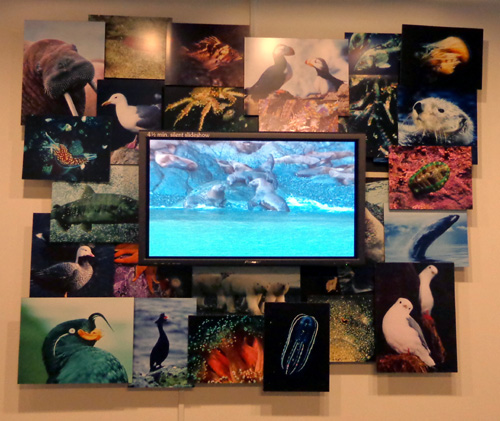
A video of Steller sea lions plays inside a photo
collage of other Alaskan marine animals.
These exhibits and the harbor seal habitat can be viewed from both the
upper and lower levels of the SeaLife Center. The bird habitat is
enclosed so the birds don't escape; the sea lion and harbor seal tanks
are open-air on the upper level.
THE SEABIRD HABITAT
We both enjoyed the seabird habitat with its rock walls, glass dome
ceiling, and 21-foot deep aquarium.
Two young women were weighing and observing birds, a young man was
taking photographs behind them, another young man was cleaning out a
rookery in the rocks, another woman was watching the whole scene, and a
couple staff members in scuba gear were cleaning out the 125,000-gallon
salt-water tank while we were there:
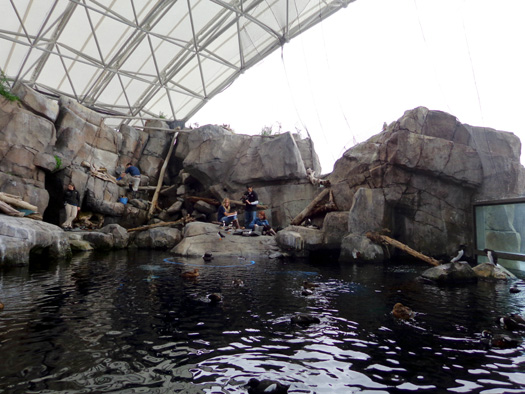
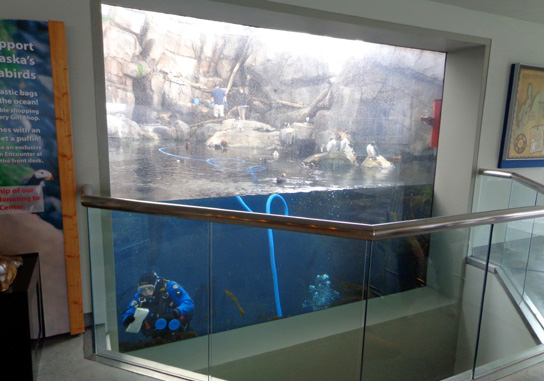
We loved watching
the comical puffins fly in the air and under water. They are much more
graceful and fast "flying" underwater than in the air:
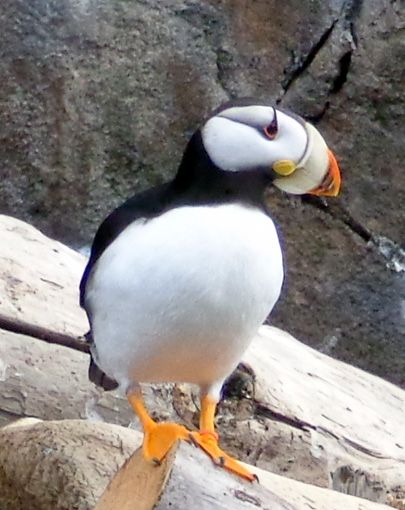
That is a horned puffin above.
There are also "tufted" puffins, referring to the tufts of yellow
feathers that adorn the top of their heads. Here are two views of
a tufted puffin:
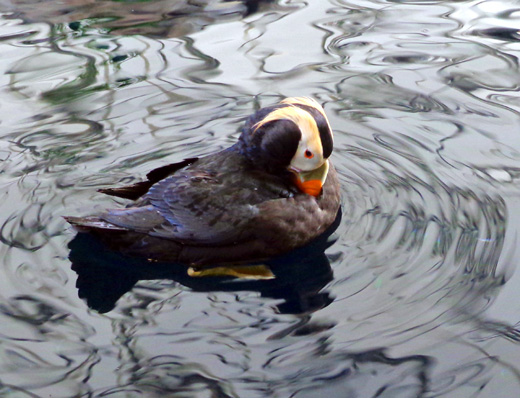
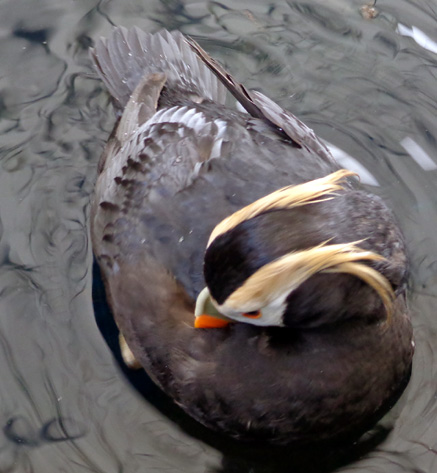
The cuddliest birds in the display were these endangered King Eider
ducks, which look exactly like soft stuffed toys:
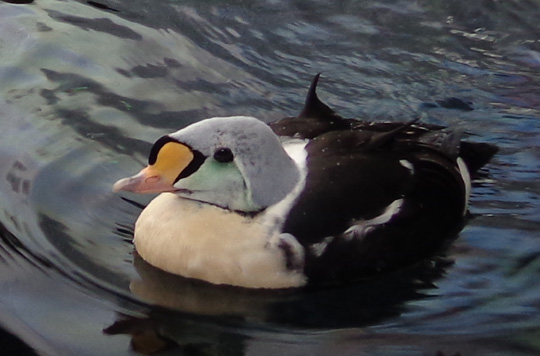
Isn't that adorable??
Common murres with chicks
in the rock crevices were very protective, diving very close to visitors
to warn them away:
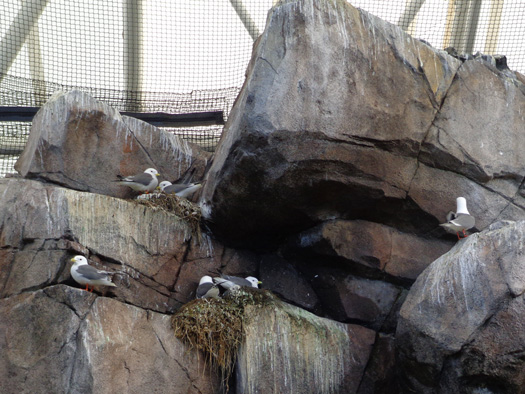
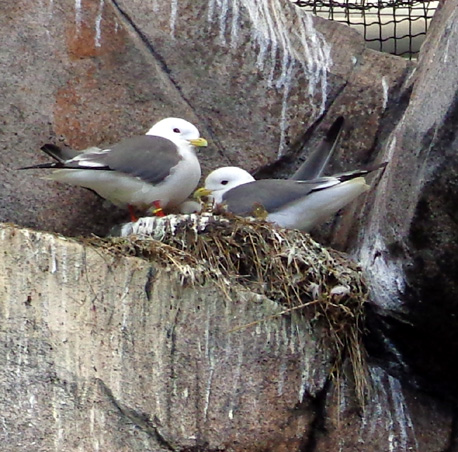
We saw thousands of murres on our catamaran tour yesterday through
Resurrection Bay to Kenai Fjords National Park.
Here are two other types of birds out of at least a dozen species in the
seabird habitat. I don't know what either of these are:
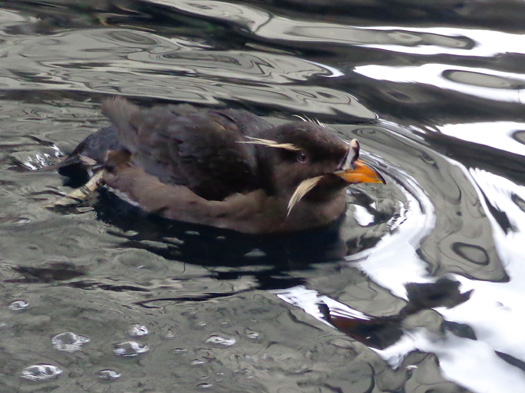
I guess the next bird was grooming itself while we were there. I took
several photos of it and they all look like the head is screwed on
backwards or the bird is floating belly-up:
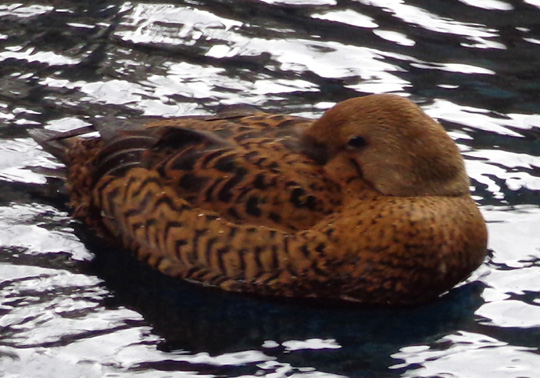
THE STELLER SEA LION HABITAT
My next favorite exhibit was the Steller sea lion habitat
with rocks that resemble haulouts where sea lions rest in Resurrection Bay.
This is an example of a sea lion "haulout" we saw on yesterday's catamaran tour:
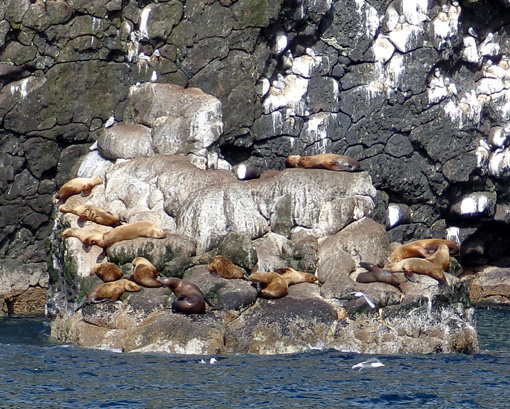
The white streaks on the rocks are poop from all the common murres that
nest in the nooks and crannies on the cliff surrounding the sea lions!
The sea lion habitat at the SeaLife Center is open air on the upper
level and contains a 162,000-gallon aquarium that can be viewed
underwater on the lower level. There are some excellent interpretive
panels between the sea lion and harbor seal exhibits that explain the
differences between the two species and describe their behavior and life cycle:
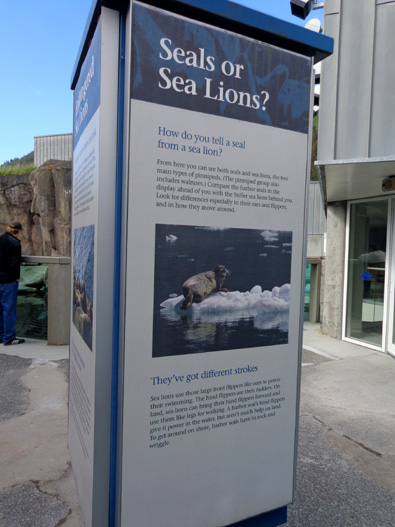
I wish I'd known more about them -- and the other creatures we
saw -- before our boat tour yesterday, although our captain gave
us lots of information during the day cruise.
When we entered the Steller sea lion habitat on the upper floor this
morning one of the sea lions was being fed and trained by a staff
member. She put the critter through its paces, including waving, bowing,
swimming in circles, hopping up on a rock, opening its mouth to show the
fish inside, etc.
Here is part of a series of pictures I took over a span of several minutes:
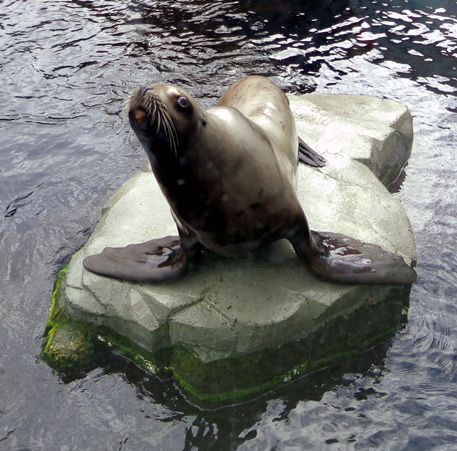
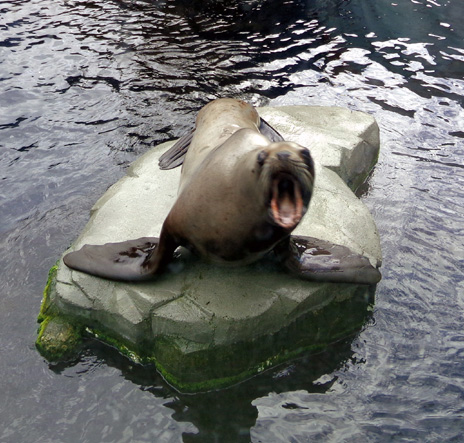
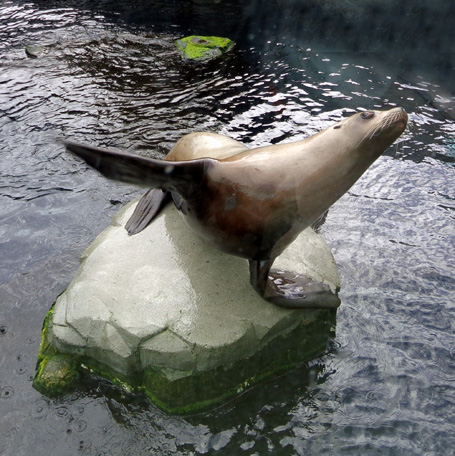
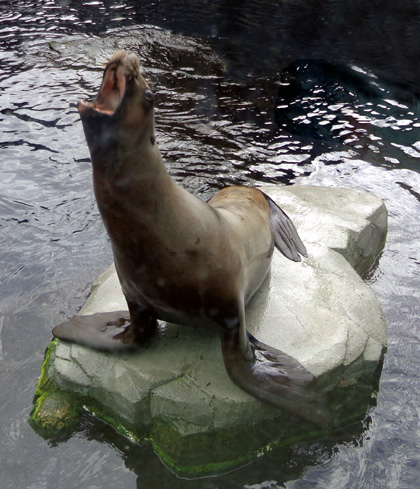
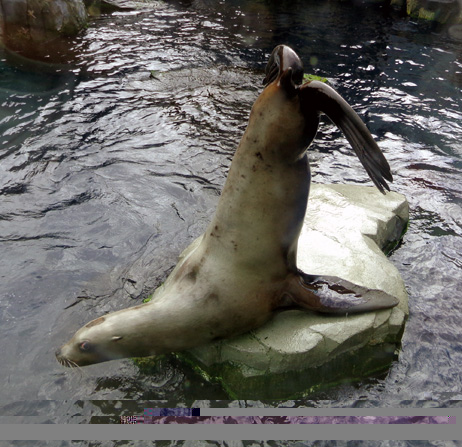
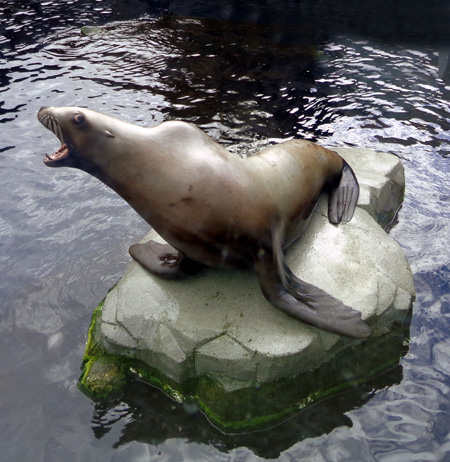
It was pretty amusing and less "fake" than performances at places like
Sea World. One of the interpretive panels explains why such play is
critical to the physical and mental health of the sea lions while they
are in captivity. The behavioral enrichment stimulates them and keeps
them active.
Another young woman came out with a second sea lion but didnít do much
with it while we watched.
We could also see the sea lions swimming underwater
in a viewing tank on the first floor when we got down there a little
later:
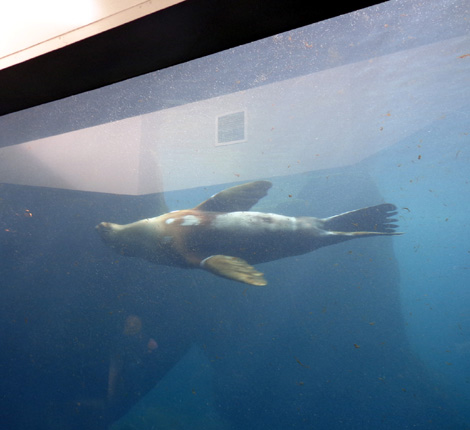
Mellow fellow, swimming on its back
Steller sea lions live in the sea off the coast of Alaska most of the
year but come ashore in May on rocky islands and outcrops to mate and
give birth to their pups. According to one of the signs, they are
sociable animals that spend most of the summer crowded together on the
rocks.
They are big -- adult females weigh about 800 pounds, males up to 2,400
pounds! Length ranges up to 11 feet. At birth the pups weigh about 40
pounds and are about three feet long.
At the end of the short summer season, once the pups have learned to swim, sea lions
disappear back into the ocean to fish and grow fat, preparing for the next
breeding season.
Unfortunately, the number of Stellers in Alaska has been decreasing over
the years for unknown reasons and they are now an endangered species.
THE HARBOR SEAL HABITAT
The third large aquarium is a 90,000-gallon harbor seal habitat that
resembles a rocky coastline. All it's missing is icebergs!
I took the next two photos from the upper,
outdoor level:
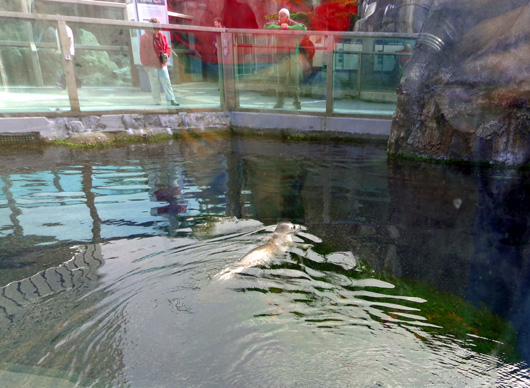
Alaska's harbor seals stay relatively close to shore and don't migrate
long distances in the winter. They can be seen year-round in the Gulf of
Alaska, often "hauled out" on beaches, low rocks, and icebergs at the
foot of tidal glaciers like Aialik.
It's more difficult for harbor seals to move around on land than for
Steller sea lions. Harbor seals have flippers instead of legs. They
can propel their rotund bodies quickly through water but have to wiggle
to get anywhere on land.
They spend about
half their time in the water, half on land or ice flows -- where they
rest, warm up, give birth, and nurse their young until they're old
enough to swim and catch their own food.
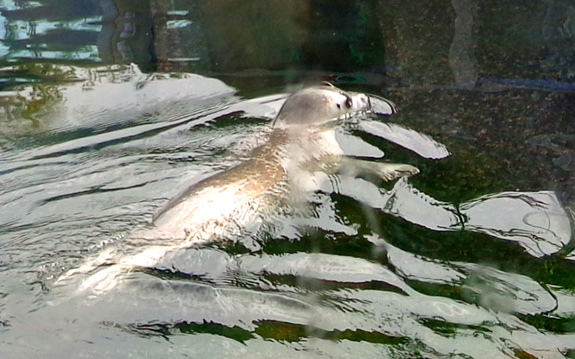
Baby harbor seals are about three feet long and weigh about 20 pounds when they
are born. They reach lengths of five to six feet long at maturity and
can weigh from 290 to 360 pounds -- considerably smaller than
Steller sea lions.
Alaskan harbor seals are protected but apparently not endangered,
according to this NOAA marine animals
site.
THE NEXT TIME
Thereís a lot to see and do at the Alaska SeaLife Center. We left after
90 minutes because we had to move to another campsite before noon. We got our
hands stamped so we could go back later if we wanted to but we were busy
enough this afternoon that we didnít return.
I'd like to go back if we're ever in Seward again. It'd be interesting
to sign up for one of the special behind-the-scenes tours to learn more
about and get closer
to the animals.
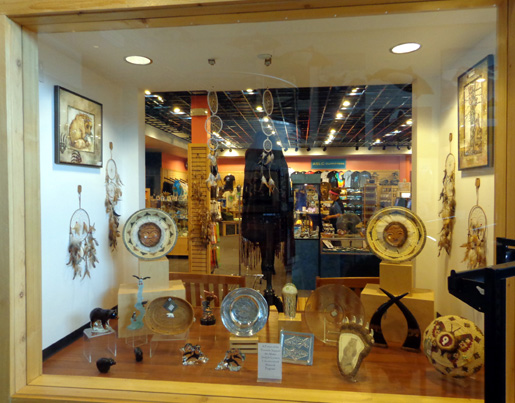
There is a small shop with Alaskan-made art and
gifts in the lobby of the SeaLife Center.
I do have one recommendation for other visitors who are interested in
both a visit to the SeaLife Center and a marine boat tour out in Resurrection
Bay and/or to Kenai Fjords:
It might be more interesting to
visit the SeaLife Center first. The more you learn about the birds and
mammals from the educational exhibits at the aquarium, the more you'll
probably understand, appreciate, and be able to identify out in their natural
habitat during a cruise.
Next entry: moving to the Air Force Campground, my hike this
afternoon on Mt. Marathon, and more information about the missing runner from
the July 4 race on the mountain